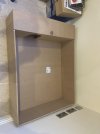Hi guys,
I have recently built a new enclosure for my horsefield tortoise . The measurements are 4ft x 3ft with a height of 1ft. What would be the optimal heat and lighting setup for indoor only?
I'm thinking about somehow attaching a T8 UVB to one of the sides with a clamped on ceramic heater?
Or would a single mercury vapor bulb be sufficient?
I have recently built a new enclosure for my horsefield tortoise . The measurements are 4ft x 3ft with a height of 1ft. What would be the optimal heat and lighting setup for indoor only?
I'm thinking about somehow attaching a T8 UVB to one of the sides with a clamped on ceramic heater?
Or would a single mercury vapor bulb be sufficient?
